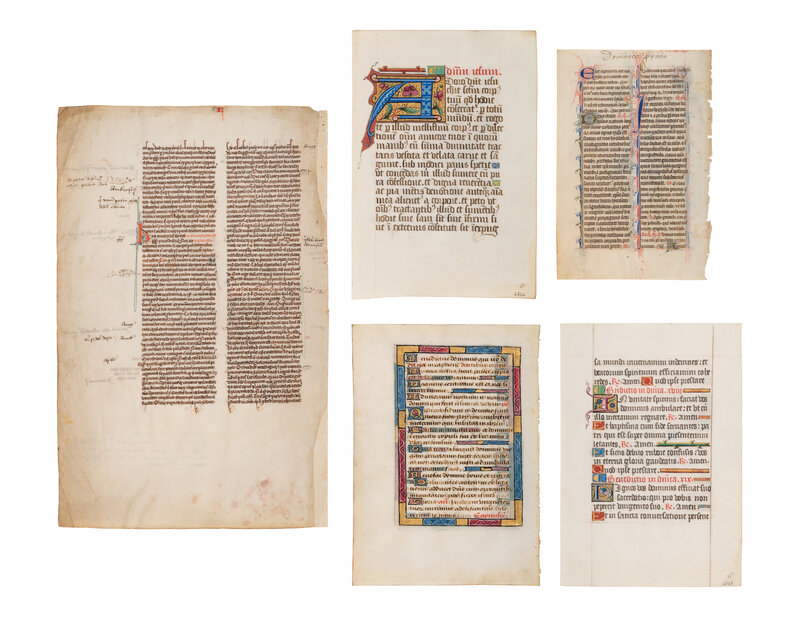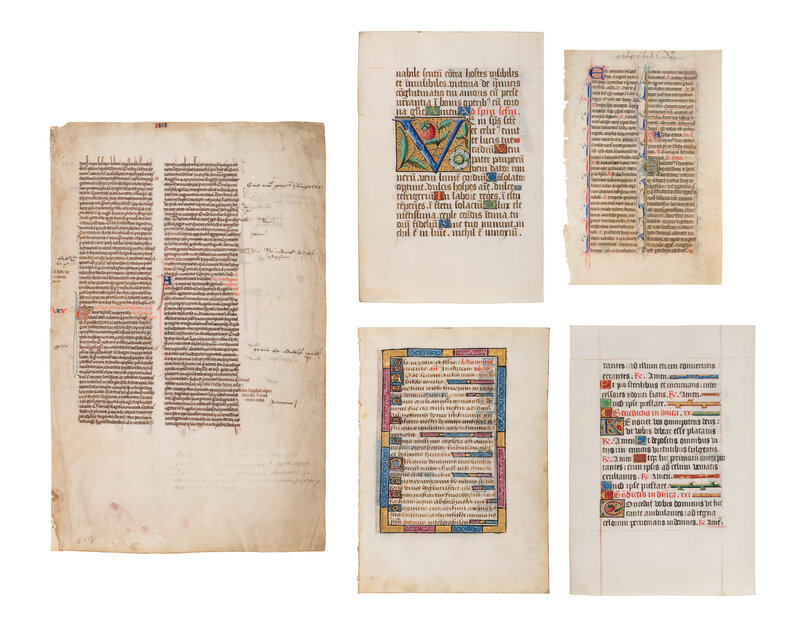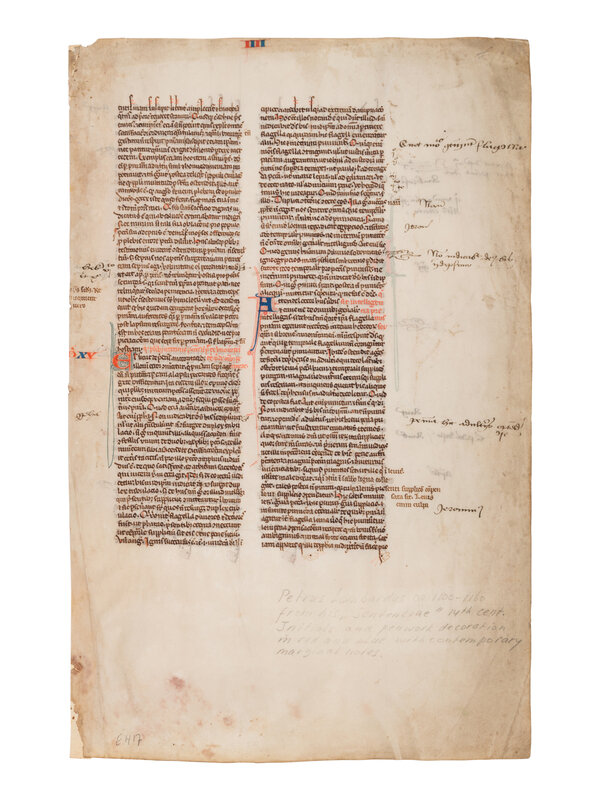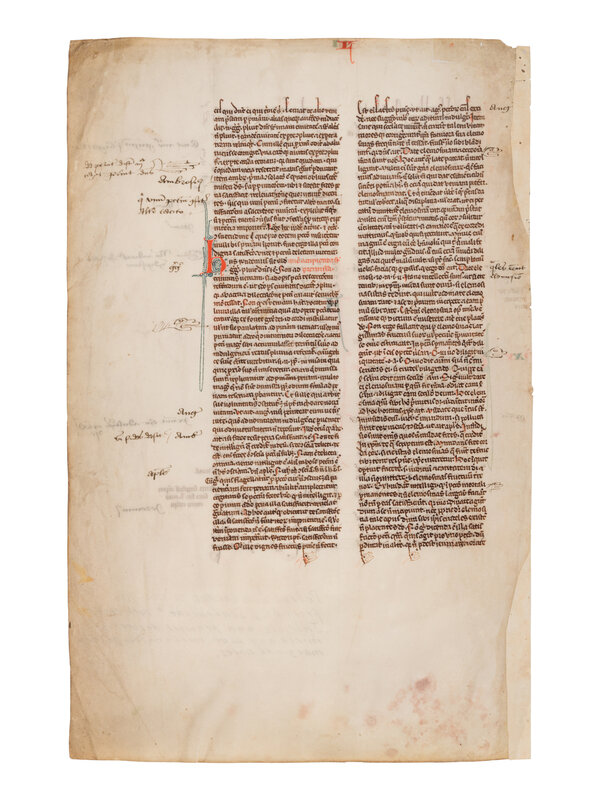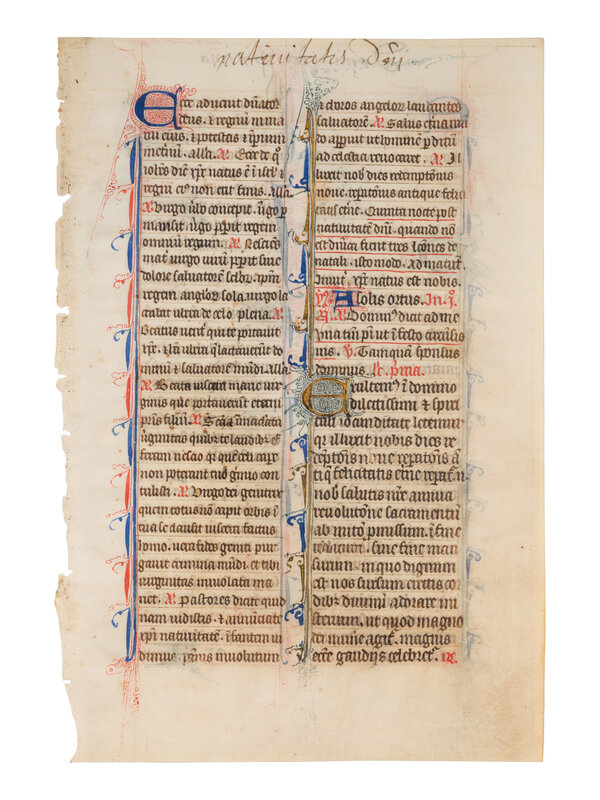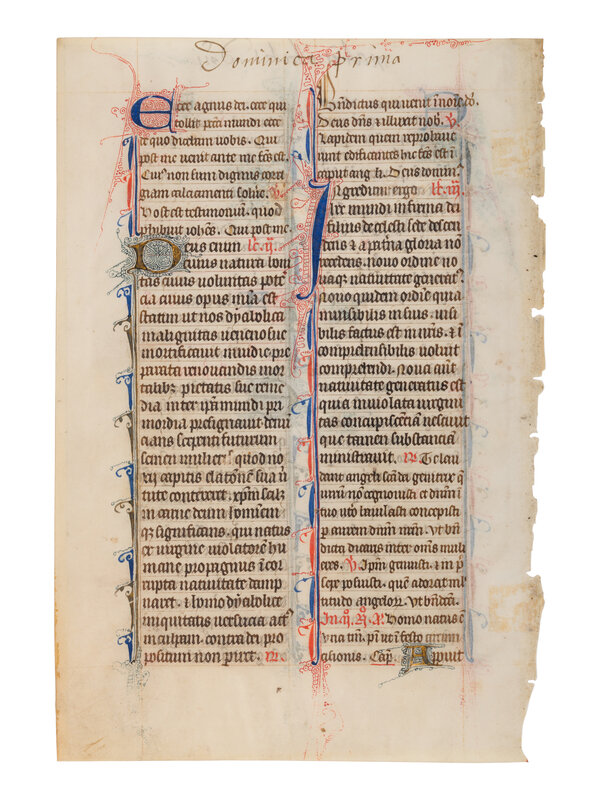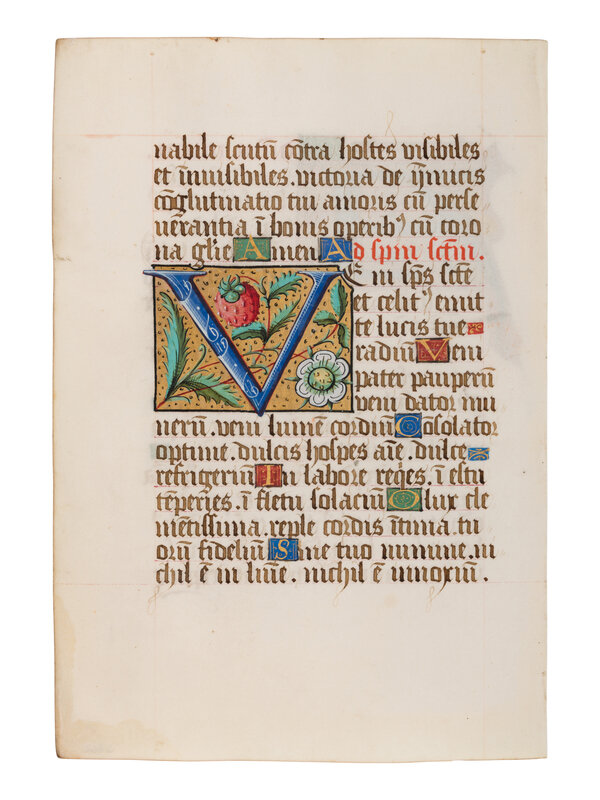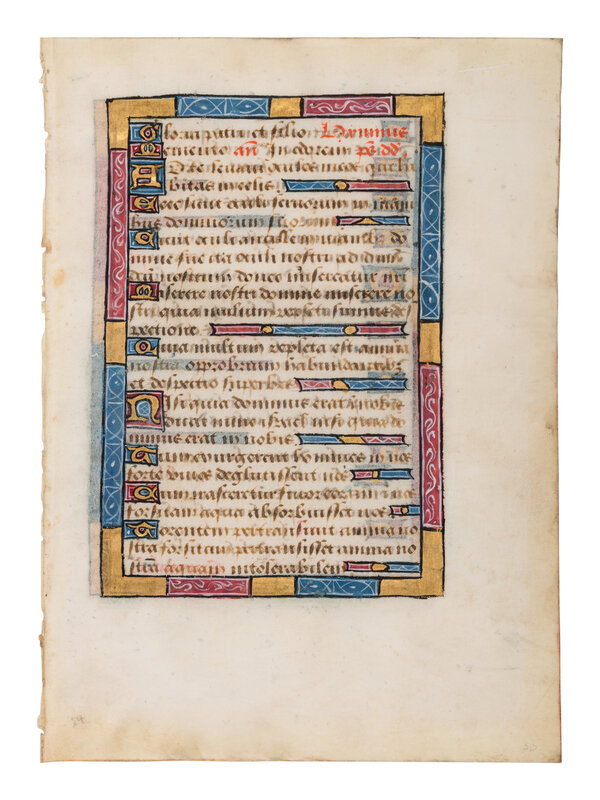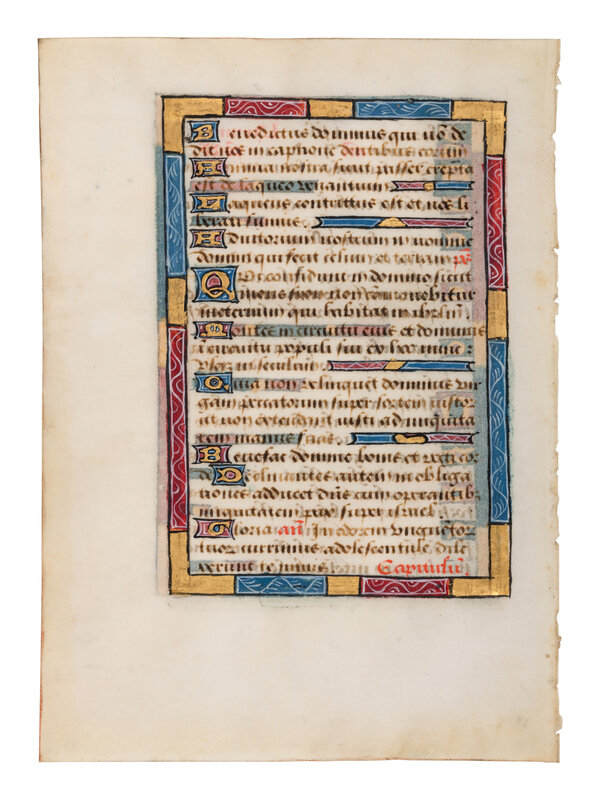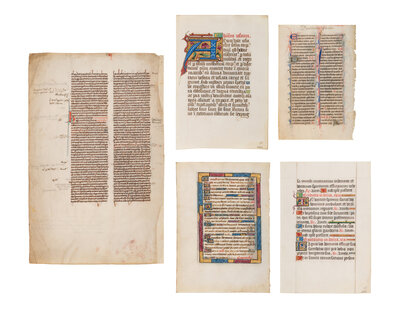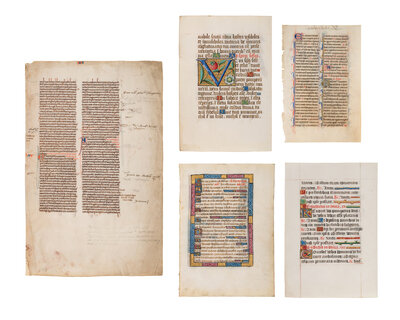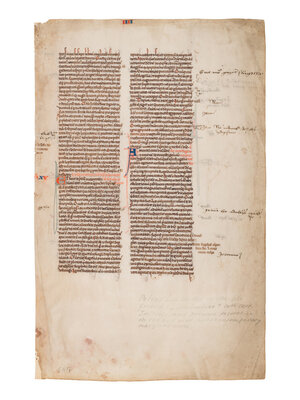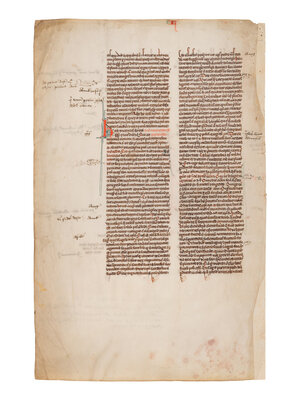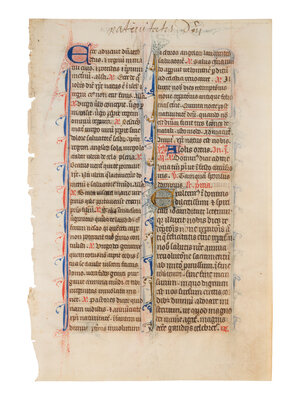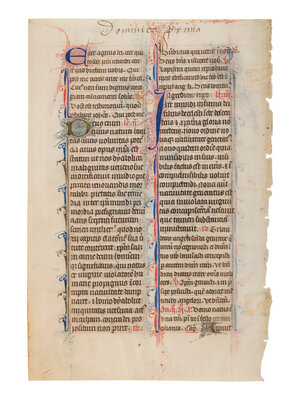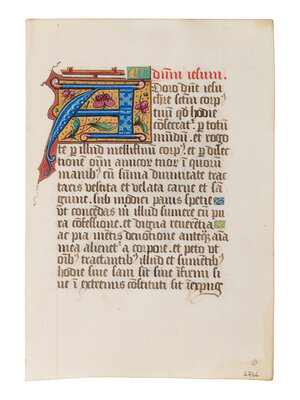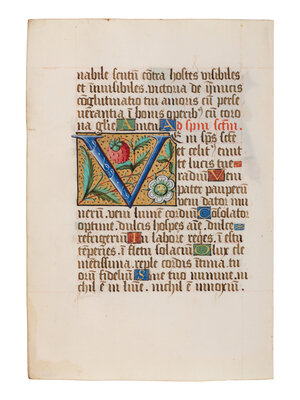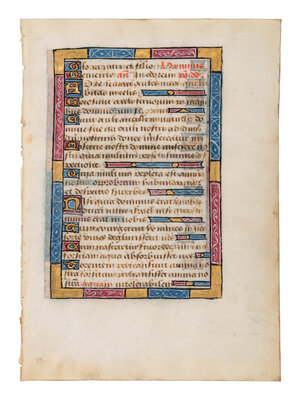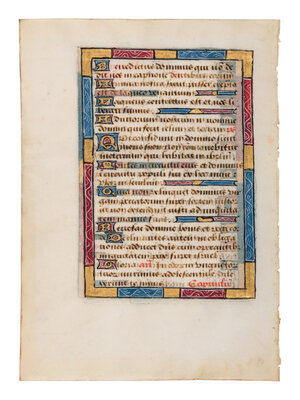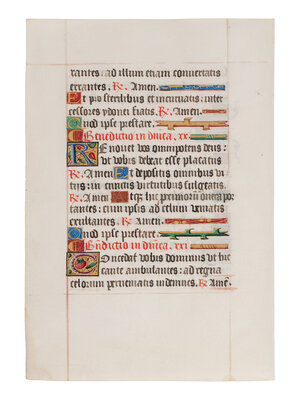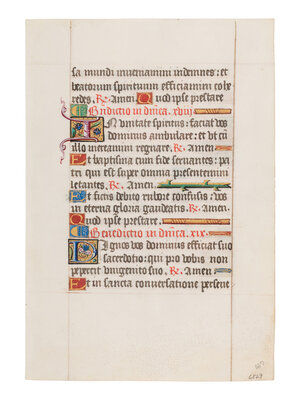Condition Report
Contact Information
Lot 34
5 remarkable leaves illuminated from the late 13th to the late 15th century in France and England.
Sale 2033 - Western Manuscripts and Miniatures
Jun 27, 2024
10:00AM CT
Live / Chicago
Own a similar item?
Estimate
$1,000 -
1,500
Price Realized
$1,270
Sold prices are inclusive of Buyer’s Premium
Lot Description
5 remarkable leaves illuminated from the late 13th to the late 15th century in France and England.
This variety of types of texts and illustrations, dates and origins, will appeal to the discerning collector or is ideal for use in the classroom.
(i) A leaf from Peter Lombard, Sententiae, in Latin, illuminated manuscript on parchment [England, c. 1280]
325 x 205 mm. Single leaf, ruled in plummet for two columns of 53 lines (written space: 200 x 120 mm), written in brown ink in a gothic bookhand, glossed in the same and in a cursive script by different hands, the upper and lower lines barred with red, four letters with calligraphic dragon heads, some capitals touched with red, rubrics in red, running titles and chapter numbers in red and blue, two-line initials alternately in red on blue penwork or blue on red penwork, extending into the height of the column (minor stains in the lower margin, minor damp stain in the upper outer corner, parchments repairs in the lower and upper inner corner, else in good condition).
This leaf comes from an especially large manuscript of Peter Lombard’s Sententiae. Composed around 1150, this theological handbook summarized the important doctrines of the Church’s Fathers. Although the leaf belonged to Book IV, its text and rubrics require further study to be identified. The wide margins would have allowed the text to be read, glossed by different hands, and proofread, for some additions appear to correct omissions.
Provenance
Private collection, California, USA, MS 258.
Parent manuscript
1. This leaf comes from a volume consisting of Books III-IV only, identified by Christopher de Hamel as copied in England around 1280, see Sotheby’s, 24 June 1980, lot 59.
2. The manuscript belonged to Edward Walmsley, whose library was sold in London in 1795. 3. Already incomplete, it was owned by Nell and Charles Wheeler, sold at their sale in New York, 29 July 1919, lot 593.
4. Acquired by calligrapher C.L. Ricketts and described in his possession by S. de Ricci.
5. Parke Bennett, New York, 24 February 1939, lot 280.
6. Sotheby’s, 24 June 1980, lot 59.
7. The manuscript was dismantled shortly after, according to Sotheby’s, London, 14 July 1981, lot 17.
Sister leaves
Sister leaves acquired before the manuscript was dismantled include one offered in 1910 by John Frederick Lewis to the Free Library, Philadelphia (now Lewis fragment XIII:373), and another owned by the late Marquess of Cholomondley, who bequeathed it to the Society for Italic Handwriting. Further sister leaves, dispersed after the manuscript was dismantled, include one in Tokyo, Keio University Library, MS 177 and one formerly in the collection of Roger Martin, while another with an historiated initial of the Annunciation introducing Book III was illustrated in A.M.W. As-Vijvers, Miniaturen en Monnikenwerk, 1999, p. 57, no. 27.
LITERATURE
On the parent manuscript, see S. de Ricci, Census of Medieval and Renaissance Manuscripts in the United States and Canada, I, 1935, p. 646, no. 185. On sister leaves, see A.M.W. As-Vijvers, Miniaturen en Monnikenwerk, 1999, p. 57, no. 27.
(ii) A leaf from a Breviary, in Latin, illuminated manuscript on parchment [France, Paris (?), c. 1350-1370]
178 x 119 mm. One leaf, ruled in brown ink in two columns of 32 lines (written space: 141 x 81 mm), the upper margins annotated in a modern hand in brown ink “nativitatis dominum” on the recto, “dominica prima” on the verso, written in brown ink in a gothic bookhand, rubrics in red, one-line initials alternately in blue on red penwork or burnished gold on blue penwork, TWO-LINE INITIALS in same, extending into bars borders of the height of the column, alternately in blue and red or gold and blue (some faints in the penwork decoration of the margins, some browning at the edges, slight tape stains on the verso, else in good condition).
This elegant leaf, illuminated with rich penwork decoration, comes from a small Breviary. Breviaries are among the most important liturgical manuscripts surviving from the Middle Ages; they gather all the sung and spoken portions of the Divine Office. The present leaf includes the reading from the fifth night after the Nativity of Christ, beginning with the antiphon “Ecce advenit dominator deus,” followed with the first, second, and third lessons. The verso concludes with the capitulum “Appuit”, presumably for the First Sunday after the Nativity. That the manuscript was illuminated in France, most likely Paris, in the middle of the fourteenth century is suggested by the style of the bar borders with dorsal motifs, by the angular gothic bookhand, and by the lemon tone of the burnished gold ground.
Provenance
Private collection, California, USA, MS 126.
Parent manuscript
As recounted by Scott Gwara, the parent manuscript was acquired in Paris in 1928 by Otto Ege (1888-1951). Folios of the Breviary were already disseminated as part of the 1944 subset titled Five Original Illuminated Manuscript Leaves from the Finer Scriptoria of Europe, numbered 9. Further leaves were included as no. 23 of Otto Ege’s seminal set of “Fifty Original Leaves from Medieval Manuscripts,” conceived in 1947.
Sister leaves
Sister leaves are to be found in several public collections, including Burlington, VT (University of Vermont, Bailey/Howe Library, item 12); Columbus, OH (State University Rare Books and Manuscripts Library, MS MR.FRAG.23); Ellensburg, WA (Central Washington University, Brooks Library, Z5948 .M6 C3); Northampton, MA (Smith College, William Allan Neilson Library); Roanoke, VA (Hollins University, Wyndham Robertson Library, HU 3).
LITERATURE
On the parent manuscript and sister leaves, see Scott Gwara, Otto Ege’s Manuscripts. A Study of Ege’s Manuscript Collections, Portfolio, and Retail Trade, University of South Carolina, 2013, pp. 22, 33, 39, 42, 45, 125-126, as “Handlist 23”.
(iii) A leaf from a Book of Hours, in Latin, illuminated manuscript on parchment [Northern France or Flanders (Belgium), c. 1480-1500)]
203 x 143 mm. Single leaf, ruled in plummet for one column of 25 lines (written space: 126 x 78 mm), written in brown ink a gothic bastarda, rubrics in red, one-line initials and line-fillers in burnished gold on alternately red and burgundy ground, with white tracery, two-line initials in same, full bar border alternately in burnished gold, blue, and burgundy with white tracery (some browning at edges, else in good condition).
This leaf comes from an as-yet unidentified Book of Hours, illuminated in the late fifteenth century. The text includes antiphons and Psalms 122, 123, and 124. It follows that it most likely belonged to the office of Sext for the Hours of the Virgin, if the manuscript was written for the liturgical use of Rome. The unusual full bar border enclosing the text is reminiscent of Flemish and Dutch illumination of the second half of the fifteenth century. Accordingly, the manuscript could have been copied in Flanders or Northern France. That a single text page
received such elaborate decoration demonstrates the luxurious nature of the commission.
Provenance
Private collection, California, USA, MS 290.
(iv) Master of François de Rohan (active Paris, c. 1520-1545)
Two leaves from a Prayerbook and Benedictional for the use of Cistercian nuns, in Latin, illuminated manuscript on parchment [Paris, c. 1520-1530].
140 x 205 mm.Two leaves, ruled in reddish brown ink for one column of 18 lines (written space: 130 x 92 mm), foliated in pencil in a modern hand in the lower right corner of the recto, the first “64,” the second “127,” alongside inventory numbers “6766” and “6829,” written in black ink in an angular Gothic bookhand by two scribes, rubrics in red, one-line versal initials in gold on alternately red, blue, and green ground, line fillers in same or in gold or green stripped trunks highlighted with liquid gold, two-line initials in red or blue on gold ground, in-filled with flowers, leaves, and fruits including strawberries, the first leaf with TWO SIX-LINE INITIALS in blue on liquid gold ground, extending in red or blue onto a red ground in the margin, in-filled with leaves, fruits, and flowers, with white tracery (dampstaining in the lower outer corner, else in very good condition).
These two leaves come from a refine Prayerbook and Benedictional for the use of Cistercians Nuns that was dismantled after its sale as part of the Library of William Foyle in 2000. Textual features demonstrate that it had been commissioned by an as-of-yet unidentified Cistercian nunnery, most likely close to Paris. These leaves belong to distinct sections of the prayerbook. The first, foliated “64,” belonged to a set of Prayers and hymns (formerly ff. 38-87) and includes the Prayer to Christ, “O Domine Jhesu Christe adoro te in cruce pendentem,” and the beginning of the “Veni Sancte Spiritus” for the feast of Pentecost. The second, foliated “127,” belonged to the Temporal Benedictions (ff. 92-133v), and includes the eighteenth to twentieth first blessings for the Sunday. Both leaves are remarkable examples of French Renaissance illumination, associating a refined, spaced, angular Gothic bookhand and wide margins with a profusion of large and small illuminated initials in gold, red, blue, and green.
The decoration of the Prayerbook and Benedictional was commissioned from the Master of François de Rohan, one of the most sought-after artists of the court of King Francis I (r. 1515-1547), responsible for the King’s personal Book of Hours, dated 1539 (New York, Metropolitan Museum of Art, 2011.353). Of likely Swiss or German origin, the Master of François de Rohan was active in Paris from c. 1510 to c. 1540. The decorative features of the present leaves are closely related to that of the Fleur de Vertu translated by archbishop François II de Rohan around 1530, after which the artist was named (Paris, BnF, MS fr. 1877), and to the large illuminated initials of the Hours of Saulx-Tavannes, dated 1533 (Paris, BnF, Arsenal, MS 640).
Provenance
Private collection, California, USA, MSS 201-202.
Parent manuscript:
1. This leaf comes from a Prayerbook and Benedictional of 152 leaves, bound in a modern red velvet, that was dismantled after its sale at Christie’s, London, 11 July 2000, lot 37, as part of the Library of William Foyle. The manuscript was illuminated for a Cistercian nunnery close to Paris, as suggested by an historiated initial introducing the profession of female novices, with nuns in the white habits of the Cistercians. The large miniature of the Hours of the Cross includes two coats of arms (chequy or and azure, a lion rampant or; argent, three roses gules, leafed vert and centred or), the second identified with the Cistercian Abbey of Foigny, Aisne, north to Paris, founded by St. Bernard of Clairvaux in 1121.
2. Later additions in a sixteenth-century hand suggest that the manuscript had passed to the mother Abbey of Cîteaux, with the prayer Sanctae Mariae Cistercii repeated twice.
3. A note of contents added on a flyleaf, reading “Il est du cabinet de Mr Chardin,” with the number ‘30’ in the lower corner, indicates that it was part of the collection of bookseller Charles Chardin (1742-1846), sold in Paris over the years 1806 to 1824.
4. The manuscript then passed to England, as suggested by the addition of a table of contents in English, and the inclusion of Latin and English titles on the binding’s spine. It is worth noting that Charles Chardin was the main supplier of English bibliophile William Beckford (1760-1844).
5. The manuscript belonged to the Library of William Foyle (1885-1963), one of the leading London booksellers of the twentieth century, housed at Beeleigh Abbey, Essex, and sold by Christie’s after the passing of William’s daughter Christina Foyle (1911-1999).
Sister leaves
A sister leaf illuminated with the large miniature of the Hours of the Cross has been exhibited as a loan from an unknown American collection at Tampa, Florida, as early as 2004 (Szépe 2004, pp. 51-52, no.18). Another sister leaf, including the text for the Blessing on the Birthplace of Most Confessors, belongs to the private collection of Jim Sims, Leaf 17b.
LITERATURE
On the parent manuscript and sister leaves, see Christie’s, 11 July 2000, lot 37, and Helena K. Szépe, Sacred Leaves. Books of Hours. Illuminated Devotion, Tampa (Fl.), University of South Florida, 2004, pp. 51-52, no. 18. Further literature on the artist includes: Myra D. Orth, “The Master of François de Rohan: A Familiar French Renaissance Miniaturist with a New Name,” in M. Brown and S. McKendrick, eds., Illuminating the Book: Makers and Interpreters. Essays in Honour of Janet Backhouse, London, 1998, pp. 69-91; Marie-Françoise Damongeot, Flor de Virtue (facsimile), Barcelona, 2007; Myra D. Orth, Renaissance Manuscripts: The Sixteenth Century, London, 2016, I, no. 59-64, pp. 204-219; Yassana Croizat-Glazer, “Sin and Redemption in the Hours of François I (1539-40) by the Master of François de Rohan,” Metropolitan Museum Journal 48 (2013): 121-142.
Freeman’s | Hindman thank Senior Consultant Sandra Hindman and Elliott Adam for their assistance in preparing this sale.
Property of a Private California Collector
